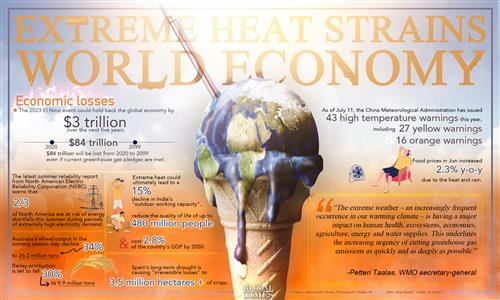Extreme weather hits China with heat sweeping the north and rainstorms in south; Beijing records 2nd highest temperature in history

People in Shenyang travel with sun protection as the high temperature continues on June 19, 2023. Photo: VCG
Many cities in China continued to issue heat and rainfall response warnings on Friday, as residents in many areas are experiencing weather extremes that could go down in history in the last few days.
According to the China Meteorological Administration (CMA), weather observations from Wednesday to Thursday showed that a total of 2,830 stations across the country recorded high temperatures above 40 C, while 2,130 stations recorded heavy rainfall.
On Friday morning, the National Meteorological Center (NMC) continued to issue high temperature orange warnings, the second highest across China’s four-level weather warming system, as the highest temperature in Beijing, Tianjin, Hebei, Shandong on Friday is expected to reach 40 C.
The CMA has started its level IV emergency response for high temperatures starting 9 am of Friday.
Beijing, the capital city located in North China, was one of the cities hit hardest by the heat wave. On Thursday, Beijing recorded a temperature of 41.1 C, breaking the all-time June temperature record of 40.6 C recorded in 1961. Also on Thursday, the same weather station recorded a ground surface temperature of 71.8 C in the afternoon, also the second highest on record.
On Thursday, most areas of Beijing saw high temperatures of 39 C or above. Weather forecasts indicate that such high temperatures will continue in the coming days.
On Friday morning, the Beijing Meteorological Station issued a red warning signal for high temperatures, the highest of China's four-level weather warning system. The last time Beijing issued such a warning was back in 2014.
On Friday afternoon, Beijing again recorded high temperatures above 40 C. Zhang Yingxin, chief forecaster from the Beijing Meteorological Station, said this is the first time since the establishment of meteorological observation stations in Beijing that high temperatures above 40 C were recorded for two consecutive days.
According to the Beijing Meteorological Station, hot weather will continue in Beijing from Friday to Sunday, with high temperatures reaching 37 to 40 degrees in most areas. By Monday, Beijing's high temperature is expected to drop back to 34 C.
This round of heat is strong, long-lasting and widespread, said Zhao Wei, chief forecaster of Beijing Meteorological Station.
"The reason for this situation is that the Beijing-Tianjin-Hebei region is under the control of a stronger warm air mass from Wednesday and the influence lasts long. Under the control of the high-pressure ridge situation, the sky is clear and with no cloud cover, which makes radiation warming more favorable and promotes warming," Zhao told China Youth Daily.
"In addition, the prolonged sunshine is conducive to the maintenance of high temperatures, while low air humidity and dry weather are also conducive to rising temperatures," Zhao said.
Since 1951, Beijing has recorded a maximum of 11 high temperature days above 35 C in June in a single year, in 1952 and 2000 respectively, and a maximum of 5 high temperature days above 37 C, in 1952. As of Thursday, Beijing has recorded nine high temperature days above 35 C and five days of high temperature days above 37 C in June 2023.
In the meantime, Tianjin and Hebei, also located in North China, are also experiencing extreme heat.
According to the Tianjin Meteorological Station, high temperatures in central Tianjin will reach 40 C on Friday. The meteorological station in Hebei Province predicted high temperature between 41 to 42 C in many cities on Friday.
While residents in North China are suffering from the hot weather, East and South China are facing the threat of heavy rain. On Friday morning, the NMC issued a yellow warning for heavy rain. According to the forecast, from Friday to Saturday, some areas in the provinces and regions of Zhejiang, Anhui, Jiangxi and Fujian in East China and Guangxi and Guangdong in South China will experience heavy rainfall, including thunderstorms and high winds in certain areas.
This summer has seen an increase in unusual weather across the globe. The US National Oceanic and Atmospheric Administration issued an alert on June 8 stating that the El Nino phenomenon has emerged and is expected to last through the winter. According to experts from the CMA, China has recently experienced a high frequency of extreme weather associated with the emergence of the El Nino phenomenon.
Zhou Bing, chief of climate service of CMA, said that this year's climate, in terms of China and the world, has been very abnormal. “The world is definitely hotter this year than in 2022 due to the appearance of El Nino event,” he told China Central Television (CCTV).
“The development of El Nino will lead to an increase in rainfall in southern China in summer and a decrease in rainfall in northern China, with a situation of flooding in the south and drought in the north,” said Zhou.
There is not likely to be a prolonged period of extreme heat in northern China, he said. But due to the influence of El Nino, the overall temperature tends to be higher than average years.
Global Times



